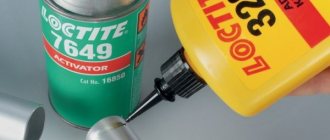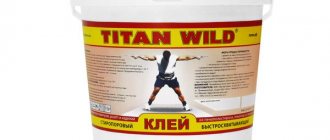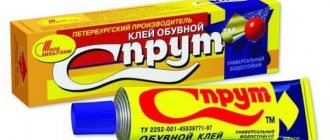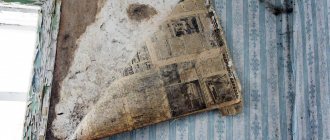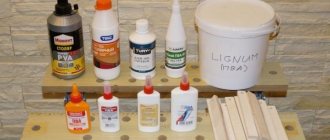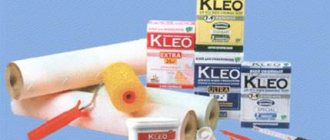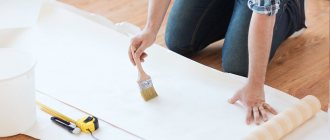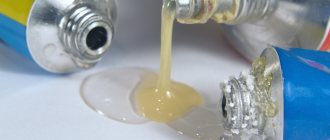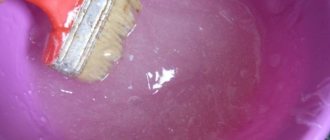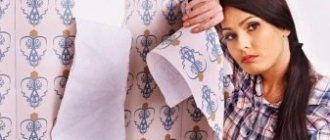Update date: 03/07/2021 13:01:14 1504 Share:
Author of the article: Vinogradov Dmitry Alekseevich
*Review of the best according to the editors of simplerule.ru. About the selection criteria. This material is subjective in nature, does not constitute advertising and does not serve as a purchase guide. Before purchasing, consultation with a specialist is required.
Non-woven fabrics and glass wallpaper are considered one of the most common materials used for decorative finishing of walls and ceilings. They owe their popularity to their relief texture, the possibility of painting and high performance qualities. In order for this coating to last for several decades, it is necessary to choose the right wallpaper glue, which will provide the necessary fixation and will not cause deformation (wetting) of the base. The peculiarity of non-woven fabrics is their increased density and increased weight (compared to paper counterparts), so the adhesive for such wallpaper must have an increased degree of fixation.
For our rating, we selected the 11 best brands of adhesives for non-woven wallpaper from well-known domestic and foreign manufacturers. We will consider dry mixtures, ready-made compositions, as well as special adhesives with a colored pigment, which plays the role of an indicator when applying the mass to the wall or the inside of the canvas.
The key factors for selecting specific items for our TOP are high quality, good adhesion, improved performance properties and optimal cost in its product group.
Types of glue, composition, characteristics, requirements for adhesive composition
All brands of products have a similar structure, differing only in the proportions of the components. Contain:
- a base of cellulose or starch derivatives (50-95%);
- polyvinyl acetate (PVA) to increase adhesion and moisture resistance;
- fungicides and antiseptics to protect against fungus.
Starch adheres worse to walls than cellulose derivatives. To compensate for this disadvantage, some companies add more PVA or other adhesion additives.
Some types of mixtures contain indicators - special color additives that become discolored during the work. They are included so that the uncoated sections of the wall are visible.
The glue contains a cellulose base, fungicides and antiseptics.
Popular manufacturing companies
Among the many companies that produce products for fixing wall coverings, there are both domestic and foreign manufacturers. Among consumers, the following companies enjoy the greatest authority in the field of glue production:
- Kleo;
- Pufas;
- Henkel;
- Quelyd.
The products of each company have their own disadvantages and advantages.
What types of glue are there?
Conventionally, the product is divided into three popular groups:
- Products for working with light types of coatings (this includes paper);
- Designed for heavy materials;
- A universal product that is suitable for both types.
Wallpaper made on non-woven material uses glue that is intended for heavy coatings. However, this is not the only product, because besides it, gluing can be done using universal glue, but it has one drawback: it is inferior to special products in terms of environmental friendliness.
On the shelves of a modern store there are hundreds of types of products, both from Russian manufacturers and foreign representatives. Each has advantages and disadvantages. In order not to get confused in the choice, professionals recommend looking at the brand of glue and coating; they should be similar; only in this way can a high quality finish be achieved.
It is important to understand that price is not the main factor in the quality of glue. So, some users claim that you can find a suitable product in every price segment. And often branded and expensive ones are inferior in some characteristics to budget models.
There are times when a buyer comes to a store, examines a product and sees the strange concept of “Indicator”. You should know that this additive affects the coloring property. That is, thanks to this, when the product is applied to the canvas, it begins to acquire a specific shade. With this property, it is much easier for the user to notice untreated areas.
The situation is completely opposite with mixtures intended for non-woven materials; such products rarely contain a specialized additive. Because there is a possibility that the color may show through the wallpaper, which will create more additional problems for the user than provide a ready-made solution. Therefore, adhesive products with indicator are more suitable for standard types.
Criteria for choosing adhesive for non-woven wallpaper
When choosing the best product, you need to pay attention to the following indicators:
- Purpose. The packaging must indicate that the product is suitable for non-woven fabrics.
- Glue consumption for non-woven wallpaper. This parameter is different for different types of powders. The indicator affects the relationship between price and quality of the product.
- Type of wallpaper used. Some of them, in addition to the non-woven base, use paper or vinyl as the top layer.
- Environmentally friendly, odorless.
Each case requires an individual approach, taking into account the listed factors.
Which glue is better (customer reviews)
According to reviews from customers who have used these types of glue, the following conclusions can be drawn:
- quelyd wallpaper adhesive for non-woven wallpaper is odorless, affordable, moisture-resistant, and easy to prepare. Consumers recommend it as a reliable and durable adhesive composition. The only downside is the lack of plastic packaging for the glue - it is packaged directly into cardboard;
- In terms of consistency and thickness, users prefer wallpaper glue for non-woven wallpaper kleo, which spreads well without forming lumps;
- Methylane glue is noted by consumers as an easy-to-use and quick-setting adhesive composition;
- The Pufas brand does not find proper approval among most interior decorators due to the formation of lumps and low adhesiveness;
- Consumers call the glue manufacturer Exclusive a good composition for gluing heavy wallpaper, but it has been noted that the glue leaves stains on light-colored wallpaper.
Having put together all the opinions of experts and people who have hung wallpaper themselves, we can come to the conclusion that the best brands are adhesives from the manufacturers Quelyd and Kleo, which have proven themselves on the positive side.
Video:
The best universal adhesive for non-woven wallpaper
Knowing the detailed characteristics of commonly used adhesives, you can go to a specialized store. You should consider the top 20 best compounds in terms of quality and reliability.
KLEO TOTAL
One of the most popular products is the product of the French brand KLEO TOTAL. This is a universal powder for all types of non-woven fabric. After dilution, the mass is easy to apply, fastens well and leaves no traces.
KLEO TOTAL is the most purchased product.
Basic properties:
- despite the starch-containing base, it has increased adhesion due to the enhanced formula;
- does not require long preparation;
- effectively protects against fungi;
- transparent after drying;
- environmentally friendly;
- retains its properties for 10 days after preparation.
The consumption of the substance is low - a pack weighing 500 g is enough for 70 m².
The disadvantage of the powder is its high price: a pack of 500 g costs 420-450 rubles. Some users note that over time, the stains from the composition turn slightly yellow.
However, most often the reviews about this wallpaper glue are positive.
Pufas Glutolin GTV
Glutolin GTV is an elite mixture for all types of premium wall coverings. It is characterized by high moisture resistance.
Advantages:
- consists of methylcellulose and PVA, which means a high degree of adhesion;
- has an antibacterial effect;
- evenly distributed with a brush and roller;
- ready in 5 minutes;
- has high moisture resistance.
Pufas Glutolin GTV is a mixture for wall coverings.
Sold in a pack weighing 300 g, which can be used to treat up to 45 m² of surface.
Among the disadvantages is the high cost: the price of packaging the product is 500-550 rubles.
“ACM Adhesiva U Universal”
The powder is produced by an Italian company. It is suitable for all types, incl. non-woven. The main advantages are low consumption and low price. For 1 sq. m only need 0.12 kg. A pack of 0.25 kg of powder is enough for 50 square meters. m, because 16 liters of water are added to it. Users note good dilution of the mixture - fast and without the formation of lumps. The price of the product ranges from 199-300 rubles. for 1 pack of powder.
“ACM Adhesiva U Universal” is an adhesive from an Italian company.
The mixture is not waterproof. In addition, its disadvantage is the starch base, which does not give confidence in the durability of the coating. Although some users write about the high quality of its fastening, it remains unknown how long everything will last.
“Quelyd Raccord for joints”
The mixture is used to strengthen joints and install curbs and repair small areas. The package contains 80 g of finished mass. The tube is enough for 40 m of joints. Cost – 250-320 rubles.
“Quelyd Raccord for joints” is a mixture for strengthening joints.
Calculation of glue consumption
As a rule, manufacturers indicate on packages with adhesive composition how much area one pack is designed for.
However, this consumption is indicated for “ideal” conditions, but it is worth considering that a plastered wall absorbs glue well, so if you do not apply a primer to it, more paste will be lost. Then for each square meter its consumption will be approximately 5–10 g more.
The following algorithm will help you correctly calculate the number of packs of wallpaper glue, according to which you need to:
- Determine the total area of the walls.
- Calculate the area of openings: windows and doors.
- Subtract the area of the openings from the total area.
- Increase the result by: 10% if the adhesive is applied with a roller, or 20% when applied with a brush.
- Record the result on paper.
- In the store, divide the area to be pasted by the consumption rate indicated on the pack.
- Round the result up.
Glue consumption indicated on the package
Since each pack of adhesive composition indicates the approximate consumption (that is, how much area it will be enough for) and the net weight, you can get the consumption in grams per 1 m2. Typically the consumption is 8–8.5 g/m2.
The best adhesive for heavy non-woven wallpaper
For heavy non-woven fabrics that use vinyl as the top layer, you need to use special products.
“Metylan Interlining Premium”
This product is manufactured by the German company Henkel. Its basis is large particles of methylcellulose and polymer additives. Advantages of the resulting mass:
- Good adhesion to gypsum board, cement plaster, lime due to the presence of special additives.
- Wallpaper holding strength.
- Long shelf life in unopened packaging, which is 3 years.
- Versatility. Long-term storage in a diluted state: up to 10 days.
- Convenient packaging. After the work is completed, there is little powder left.
- Small consumption: per 1 sq. m will require 0.17 kg of mass. A pack weighing 250 g is enough for 30 square meters. m.
- The presence of antifungal additives, which allows the coating to be used in the kitchen, on the veranda, etc.
- Turns on a pink indicator that becomes discolored after drying.
“Metylan Interlining Premium” is a product of a German company.
The mass sets quickly. The disadvantages of the substance include:
- high cost - for a pack weighing 250 g you need to pay from 314-400 rubles;
- increase in consumption when working with embossed materials up to 0.19 kg/m²;
- stringent surface requirements.
Pufas Glutolin GTX rubin
This is another top-class product from the German company PUFAS. It is designed for fastening heavy wall coverings weighing over 250 g/m², including repair and painting non-woven material for painting. Used for finishing rooms with designer and luxury coatings.
The product is distinguished by its enhanced formula, environmental friendliness and good compatibility with lime and plaster.
The main advantages of the resulting mass:
- reliable fastening;
- versatility (for different types);
- high adhesion (strong initial adhesion to the surface);
- high viscosity;
- moisture resistance;
- antibacterial effect.
Pufas Glutolin GTX rubin is an extra-class glue.
The mass consists of methylcellulose and PVA polymer.
The package includes 200 g of powder. A pack is enough for 20 square meters. m. Packaging price – 450 rub.
Premium Exclusive
Buyers call Exclusive premium non-woven adhesive one of the best compositions for heavy non-woven wallpaper, as well as vinyl-based wallpaper. How to dilute it is indicated in the instructions on the product packaging.
Premium Exclusive – adhesive for heavy non-woven wallpaper.
“Moment Non-woven”: cheap and cheerful
One of the cheapest compositions that provides good adhesion to the wall for smooth wallpaper. The brand belongs to the German concern Henkel, but production has been going on in Russia for a long time (hence the low price).
The advantages include:
- popularity - available in almost all stores;
- Can be stored diluted for several days;
- After application to the wall, it sets gradually, which allows you to align the joints.
The disadvantages include the poor adhesion of voluminous textured and heavy wallpapers - they require more serious compositions. It also requires careful dilution and thorough stirring to obtain a uniform consistency - there is a risk of lumps forming.
European-quality renovation: clichés or quality standards?
European-quality renovation is a concept that came into use at the beginning of the 2000s, as a synonym for a fresh, renovated apartment. And now…
The best ready-made adhesives
There are solutions that you don’t need to make yourself, because... they are already prepared for use. Such products are a little more expensive, but they reduce the time for kneading and are uniform in structure. In addition, when using a ready-made solution, you cannot make a mistake when calculating the proportions for its preparation.
PUFAS OK
The ready-to-use mixture from the German concern PUFAS is suitable for fixing all types of wall coverings and is not afraid of moisture during operation. Neutral pH reaction eliminates the appearance of yellow spots. Consumption: 1 kg/6 m² (150 g/m²).
PUFAS OK is a ready-made mixture from a German concern.
“Metylan for joints”
This is a ready-made universal product for securing joints of all types of coatings, incl. non-woven fabric The tube contains 60 g of powder.
Its advantages:
- water resistance;
- versatility;
- reliability of fastening;
- ready to eat;
- simplicity, ease of use.
“Metylan for joints” is a universal adhesive.
Buyers respond well to this product.
They note great convenience for those who have small children or animals, because... The mass helps in the repair of wall paintings.
Price of 1 tube – 186-295 rubles.
Oscar
This product is intended for installing glass wallpaper, but it also holds non-woven fabric well. Its main distinguishing feature is the ability to use it on any surface, be it drywall, wood or concrete. The substance has an increased ability to adhere to the base, which reliably holds the canvas. Dry mixes under the Oscar brand are produced by the Russian company Oscar-Vostok. They have a number of advantages:
- safe for the health of people, pets and the environment, which is confirmed by the sanitary and epidemiological conclusion of the State Sanitary and Epidemiological Supervision Service;
- effective when used, because from 500 g of dry powder, 8-10 kg of ready-made solution is obtained;
- convenient and easy to prepare, diluted in cold water and ready to use in 10 minutes;
- have a small consumption: 250-300 g of finished product per 1 sq. m of wall canvas;
- retain their properties for a long time when the prepared solution is stored in a closed container - 2 months.
Oscar is a product for glass wallpaper.
Oscar's ready-made solution can be used in combination with glass, textile or vinyl coverings.
Pufas Glutolin GTV
A universal type of glue is well suited for non-woven wallpaper, where the glue itself is applied only to the wall. Thanks to special components, the glue has significantly increased its adhesive ability, so you won’t have to worry about the quality of gluing heavy and dense wallpaper. For the finished mixture, just dilute the glue with water and knead for 5 minutes. One 300 gram pack of glue should be enough for 8-11 tubes of wallpaper.
Pros:
- Universal glue;
- Easily diluted with water;
- Suitable for paper and vinyl wallpaper;
- Economical consumption;
- Strong grip.
The best glue for non-woven wallpaper for painting
To choose wallpaper adhesive for painting, you need to purchase a high-quality mixture that can hold a canvas with gradually increasing weight.
“QUELYD Special-Flizelin”
This powder made in the Netherlands is praised by many buyers. One of the advantages they call is quick preparation, which results in an excellent, odorless mixture. The solution leaves no traces and glides well, allowing you to carefully combine the design. It is easy to apply.
The only drawback is the high consumption. A pack weighing 300 g is used to make 40 m² of canvas. However, some users note that in reality they have to spend a little more.
“QUELYD Spets-Flizelin” – instant powder.
Reviews about “Quelyd Spets-Flizelin” glue are also mostly positive.
PUFAS GT Vlies Direct
This product was developed by the German concern PUFAS specifically for a new method of applying the solution - on the wall, and not on the canvas.
Main characteristics of the fixing mass:
- visible application due to the presence of a color indicator;
- ready for use 5 minutes after preparation;
- transparency of the solution;
- the ability, if necessary, to remove the canvas dry without soaking;
- average consumption rate: 325 g of powder is enough for 50 m²;
- shelf life of at least 5 years from the date of manufacture;
- high adhesion;
- good dissolution without formation of lumps.
PUFAS GT Vlies Direct – a product for application on the wall.
The price of the product is about 350 rubles.
How best to dilute and application methods
To prepare a high-quality composition, a person must have an enamel bucket. Glue powder is placed in the container. Then water is added, which should be at room temperature. You need to pour as much as indicated on the package. If it is important for a person to pre-prime the surface, then it is important to dilute the mixture until a more liquid consistency is obtained. To stir the composition, improvised means or specialized construction equipment are used. After the first stage, you need to give the glue time to set, then you need to stir the mixture again and begin finishing work
It is also important to understand that the resulting composition is applied not to the wallpaper, but to the wall. The whole process should start from the window. The composition must be applied only to the area where the pasting is carried out, so the user can reduce consumption because the areas will not dry out quickly. Wallpaper can be either completely glued or cut into pieces. When unrolling a roll, a person needs to tightly dock it to the wall from top to bottom; it is important to smooth everything out not with your hand, but with a special roller. If small residues appear, they should be removed immediately using a damp cloth. Because if you allow them to dry out, the stains will ruin the entire appearance upon close examination.
Main recommendations
To choose a suitable adhesive that will ensure high adhesion, it is important for the user to know:
- Instruments should be washed only in warm water;
- Drafts during pasting are unacceptable;
- To ensure high-quality adhesion, the selected surface must be treated with chlorinated water, and then standard;
- First, wallpaper is purchased, and only then the appropriate composition. It's best to refrain from buying all-purpose adhesives because they are not that durable;
- It is important to have solid rollers, only with their help the glue consumption will be much less;
- When stirring occurs, the glue is added to the water in a small stream;
- A finish is considered to be of high quality when, when removing the wallpaper, it is not deformed in the middle, but is removed evenly along the seams.
The best antifungal
In the structure of the mixture used in rooms with high humidity - the kitchen and even the bathroom, the presence of an antifungal additive is important. Damp walls are a good environment for the development of mold, so in dachas and verandas mixtures with a special additive against the formation of microorganisms are also preferred.
Most products include this component. Its content is sometimes 3.4% by weight of the product.
KLEO ULTRA
The powder has a high content of antifungal component. The technical characteristics of the product are similar to KLEO TOTAL:
- There is double packaging that prevents moisture from entering;
- the mass is transparent after drying;
- dissolves quickly and without lumps;
- good glide makes it easy to adjust the blade;
- harmless to people and animals;
- the product does not allow fungus to develop;
- a pack of powder is enough for 70 m² of wall canvas;
- dilutes well in cold water;
- does not react with paints;
- When ready, it can be stored for 10 days.
KLEO ULTRA is a powder with an antifungal component.
The price of a package weighing 500 g is 559 rubles.
There is also a ready-made mass, it needs 0.2-0.33 kg/sq. m. Its cost is 765 rubles. for a container with a ready-made solution.
Reviews about Kleo glue are mostly positive, but some complain about the thick structure, quick drying and peeling edges. Thus, “Cleo” is a good product, but you need to have some skill when using it.
“Interlining Moment”
“Moment Interlining” is the Russian version of the product “Metylan Interlining”, because Under this name, a product developed in Germany is produced in the Russian Federation.
“Moment Interlining” is a Russian product developed in Germany.
The powder has a high binding capacity. The product is used for making smooth and structured non-woven coatings. Its characteristics:
- contains starch and methylcellulose as a base;
- applied to the wall and makes it possible to easily adjust the canvas;
- has a high fixing ability;
- the finished mixture is stored in a closed container for up to 7 days at room temperature;
- contains antifungal additives;
- consumption is 160-250 ml of ready solution/sq. m;
- withstands high humidity;
- compatible with lime and cement;
- environmentally friendly.
“ECON Non-woven”
This inexpensive glue is produced at a Russian enterprise under license from the German company Henkel. Its advantages:
- enhanced formula with methylcellulose;
- antifungal effect;
- reliable fastening of the canvas;
- convenient and easy to use.
“EKON Non-woven” is an inexpensive glue made by a Russian company.
The mass is ready for use 15 minutes after preparation.
The price of the adhesive is 160 rubles. per package of 0.2 kg. According to the manufacturer, it is enough for 32 m².
However, users note that the mass is quickly absorbed, despite the application of a primer, so in reality the consumption may be more than stated.
Another drawback is the shine at the joints, visible on dark wallpaper: in some cases, traces of the application of the solution remain.
But 80% of buyers were satisfied with the quality of the product.
Which brand of wallpaper glue is best to choose?
Surveys show that buyers do not think about choosing a manufacturer, often choosing consumables due to advertising or recommendations. Most experts still advise paying attention to this aspect, since the brand’s reputation carries with it a guarantee of product quality. The rating provides brief information on each company from the TOP 2021 that produces wallpaper adhesive:
- Semin is a brand from France, founded in 1996. It produces construction and finishing materials for professional renovation work, importing products in more than 40 countries.
- Pufas is a manufacturer from Germany that produces finishing materials, cleaning products, tools and paints for interior decoration. Created in 1928, the brand offers a large selection of products and often holds promotions and prize draws for customers.
- Ekon is a German company that produces building mixtures and raw materials for finishing; it is of good quality, but is not widely used in the Russian Federation. This brand is quite difficult to find in stores, so customers prefer to order goods online.
- Quelyd is another manufacturer from France specializing exclusively in the production of adhesives. Founded in 1924, the company has its own laboratory in which new technologies for high-quality raw materials are developed.
- Metylan is a trademark of the largest German corporation Henkel. It has been producing adhesive mixtures since 1953 and has international standard certificates confirming the quality and safety of the product.
- Kleo is a French manufacturer of adhesives and auxiliary materials for decoration and repair. When developing raw materials, it uses only new technologies, focusing on the reliability and safety of products.
- Moment is another well-known brand of the Henkel concern, producing adhesives, sealants and polyurethane foam. The company was registered in Russia in 1973 and, thanks to its quality, has gained the trust of users during this time.
- Lakra is one of the largest manufacturers of coatings and adhesive mixtures in Russia. Offers environmentally friendly, safe products at reasonable prices.
- Oscar is a brand from Sweden that produces high-quality mixtures and wallpaper for professional craftsmen, and has its own production facilities in Finland, China, and Russia.
- Norme Color is a brand that produces paints, primers, adhesives and glass wallpaper for professional use. In the production of mixtures for interior work, we use environmentally friendly and safe raw materials, which is confirmed by quality certificates.
Best waterproof
In rooms with high humidity, not only antifungal additives in the composition of the product are important, but also the water resistance of the product.
“Metylan Interlining Ultra Premium”
“Methylan Non-woven Ultra Premium” is intended for structural fabrics on a non-woven non-woven base. You can use wallpaper glue for painting with a smooth or corrugated surface, with hot stamping.
In addition to increased moisture resistance, it has many advantages. Prepared mass:
- has high strength due to the enhanced formula;
- applied directly to the wall;
- glides well due to the methylcellulose-based formula;
- protects against mold;
- can be removed dry during subsequent repairs;
- withstands temperature changes.
“Methylane Interlining Ultra Premium” is an adhesive for structural fabrics.
The substance for preparing the fixing mass is sold in 2 types of packaging: 0.25 and 0.5 kg. A pack is enough for 30 and 64 m² of canvas, respectively.
“Quelyd Special non-woven fabric”
In places with high humidity, you can use the previously mentioned “Quelyd Special Non-woven Lining”. It also has the necessary qualities and increased resistance to water. Therefore, it can be used in the kitchen, in the bathroom, on an external cold wall.
“Quelyd Special non-woven fabric” has increased durability.
SEMIN Sem-Murale
The product from the French manufacturer SEMIN Sem-Murale is a polymer water-dispersion composition with high adhesive ability. It is recommended by many manufacturers of heavy wallpaper and various luxury wall coverings.
Ensures good fit of joints, no peeling or stains. The solution glides perfectly, does not flow or drip during application.
After drying, the substance is moisture resistant, durable, and transparent. Does not turn yellow, does not darken, protected from fungus. This is an environmentally friendly product.
SEMIN Sem-Murale is a French remedy.
Its main advantages:
- high viscosity;
- thixotropy - does not flow or drip;
- ease of adjustment;
- transparency after drying;
- moisture resistance.
Comparison table of technical characteristics
This rating contains the best wallpaper adhesives today.
| Model | Purpose | Consumption | Water consumption |
| Quelyd Special interlining | for vinyl wallpaper, for non-woven wallpaper, for paintable wallpaper | non-woven - 0.15 kg/sq.m, for painting - 0.13 kg/sq.m | non-woven - 16.5 l/kg, for painting - 15 l/kg |
| KLEO EXTRA Non-woven | for non-woven wallpaper | 0.18 – 0.2 kg/sq.m | 24 l/kg |
| Metylan Interlining Ultra Premium | for non-woven wallpaper, for paintable wallpaper | on a non-woven smooth base - 0.16 - 0.17 kg/sq.m, on a non-woven textured base - 0.15 - 0.19 kg/sq.m | on a non-woven smooth base - 20 l/kg, on a non-woven textured base - 18 l/kg |
| Moment Interlining | for non-woven wallpaper | 0.15 – 0.2 kg/sq.m | 15.5 l/kg |
| ACM Adhesiva U Universal | for vinyl wallpaper, for non-woven wallpaper, for paper wallpaper | paper - 0.12 kg/sq.m, lightweight vinyl - 0.15 kg/sq.m, non-woven - 0.17 kg/sq.m | paper - 23 l/kg, lightweight vinyl - 20 l/kg, non-woven - 16 l/kg |
| Oscar Ready to use | for glass wallpaper and fiberglass | 0.2 – 0.25 kg/sq.m | 18 l/kg |
| Metylan Universal Premium | for vinyl wallpaper, for paper wallpaper | paper - 0.16 - 0.18 kg/sq.m, vinyl - 0.15 - 0.18 kg/sq.m | paper - 30 l/kg, vinyl - 20 l/kg |
Below is a detailed description.
Best with indicator
The presence of an indicator makes it easier to install wallpaper, because thanks to it, poorly treated areas are visible. After drying, the indicator disappears. This component is needed by home craftsmen who do not have sufficient experience.
“Tytan Euro-Line Vinyl”
This product is made on the basis of modified starches by the German concern Emsland-Starke GMBH using antiseptic and antifungal additives, as well as a light pink indicator.
Its advantages:
- good sliding of wallpaper, because it has a gel structure;
- does not change the color, texture and geometric dimensions of the wallpaper before and after painting;
- does not form lumps when diluted;
- contains a light pink indicator for ease of application, which disappears after drying;
- the diluted mass can be stored in a closed container for up to 20-23 days;
- the solution is ready for use after 5 minutes.
“Tytan Euro-Line Vinyl” is a starch-based product.
“PUFAS EURO 3000 Non-woven”
PUFAS EURO was developed directly for non-woven wallpaper. When using, it is important to follow the process technology. The blue indicator allows you to control the uniformity of glue application. Consumption: 200-250 ml/m², 300 g packaging is enough for 25-45 m².
“PUFAS EURO 3000 Non-woven” – wallpaper adhesive.
The cost of a package of glue is 570-650 rubles.
“Krass Non-woven”
This is a special adhesive for all types of wallpaper on a non-woven non-woven base, incl. for painting. It contains a pink indicator.
Its advantages:
- has enhanced adhesive ability;
- contains methylcellulose additives;
- suitable for wet areas;
- contains a pink indicator for complete control over the application of glue;
- as the glue dries, it becomes transparent;
- includes antifungal additives;
- the glue is ready after dilution is 3 minutes;
- during subsequent repairs it can be easily removed without leaving marks on the wall.
“Krass Non-woven” is a composition for all types of wallpaper on a non-woven basis.
Rating of wallpaper adhesives
Experts who were able to give a clear analysis of adhesive compositions participated in compiling the rating. Testing was carried out to reveal the advantages and disadvantages of the products, and reviews from real people helped compile full reviews. When including nominees in the TOP 2021, the following properties were taken into account:
- Compound;
- Consistency;
- Consumption;
- Smell;
- Drying time;
- Resistance to temperature differences;
- Antibacterial properties;
- Price.
Analyzing the listed qualities, experts compiled a TOP 2021 rating. It included only the best adhesives for non-woven, vinyl, paper and glass wallpaper.
The best paints for wood
Step-by-step instructions for working with glue
When working with non-woven fabric, it is important to follow the method of preparing the surface, preparing the composition and process technology.
Calculation of glue consumption
You need to calculate the glue consumption for non-woven fabric based on the structure of the fabric. The thicker the coating, the more massive layer of solution it will require.
On average, 0.8 kg of dry glue is enough for 66 m². Based on these parameters, about 12 g of dry matter is consumed per 1 m². The consumption of adhesive for non-woven wallpaper can also be affected by the tools that will be used and the experience of applying the composition.
How to breed
Pour the powder in a thin stream into prepared water at room temperature, stirring constantly to avoid lumps. Its quantity is indicated on the package. After this, let the solution brew. The time for swelling is from 5 to 15 minutes.
The powder is poured into water at room temperature and stirred.
The diluted composition is immediately applied to the prepared surface.
How to apply
To make non-woven wall coverings, the adhesive is applied directly to the wall and not to the panel. The surface is pre-puttyed and primed.
The method of application - brush or roller - affects the consumption of the composition. In the latter case, 15% more paste will be required.
How to store
The diluted substance is stored in a tightly closed container for 7-10 days. For this purpose, dark places with low temperatures are preferred.
Dry mixtures retain their properties for the period indicated on the packaging.
How to choose glue for non-woven fabrics
When choosing wallpaper glue, you should adhere to the following factors:
- What type of wallpaper will be used.
- Type of mixture (dry or ready-made).
- Approximate area of work.
- Additional features.
If we are talking about non-woven fabric or glass wallpaper, it is necessary to choose adhesive mixtures whose composition is specially designed for canvases of this type. Most adhesives are universal, but show best results specifically for a specific type of wallpaper.
All wallpaper adhesives, according to their initial consistency, are divided into two groups - dry mixtures and ready-to-use compositions. In the first case, the user receives bags of dry powder or flakes, which are “semi-finished products.” To obtain glue, it is necessary to dilute the mixture with water and stir evenly until a homogeneous composition is formed. The advantage of dry glue is its long shelf life, which is approximately 5 years. Among the disadvantages, it is worth noting the need to independently obtain the adhesive mass, as well as the not very long shelf life of glue residues after use.
Ready-made mixtures are produced at the required consistency in sealed containers. Their main advantage is the ability to use immediately after opening the package, without selecting proportions or mixing components. Unused glue can be stored in the package for 2-3 weeks, which is important if wallpapering takes several days.
When selecting a specific brand of wallpaper glue, you need to focus on the product consumption. Most dry mixes are packaged in bags of 250-500 grams, each of which is enough for 40-50 m2. Consumption may vary depending on the type of surface, layer thickness and method of applying the adhesive. Ready-made formulations are produced in buckets with a volume of 3 to 15 liters. The average consumption of the finished mixture is 1 liter per 5-7m2.
Among the additional properties of wallpaper glue, we can note the presence of an indicator. This is a special colored pigment that gives the mixture a certain shade (for example, pink or blue). This allows you to control the thickness of the layer and the area of application of the composition on the wall, ceiling or surface of the canvas. When dry, the pigment becomes discolored and the glue becomes transparent.
Another additional property of the glue is frost resistance, which is typical for some brands of ready-made mixtures.
Correctly selected adhesive for non-woven wallpaper will ensure high fixation of the canvases, will be easy to apply, and the decorative coatings themselves will last on the walls and ceilings for several decades.
Useful tips
For those who are taking on wall finishing for the first time, it is better to take into account the recommendations of specialists and the technology of the process.
Preparing the walls
When installing non-woven fabric, it is important to prepare the surface well so that it is even, smooth and does not absorb the applied substance.
The surface is carefully leveled and puttied, taking into account that the gray plaster can be visible through.
Prime with industrial compounds 2 times.
After gluing
The coating dries within 3-5 days at a temperature of 25°. The room is not ventilated and the air conditioning is not turned on for at least 1 day. Monitor the humidity level - it should be kept at an average level.
How to glue
The process of gluing non-woven wallpaper is not complicated. The main thing is to strictly follow the plan and do everything efficiently.
Preparatory activities
Before you start gluing the canvases, you need to thoroughly prepare the surface. To do this, you will need to use the following action plan:
- Remove all baseboards on the floor . If they are old and broken, then they can be removed using a nail puller, without compromising the integrity of the products. If laminate is laid on the floor, then after wallpapering it is better to attach a laminated MDF baseboard.
- Unscrew all screws and nails . Disconnect sockets and switches.
- Remove older canvas. If they don’t come off well, you can wet them with water, wait and pry them off with a spatula. You need to remove everything down to the smallest pieces. If this is not done, then the new surface will have irregularities.
- Using starting putty, repair all cracks and chips on the surface. When it hardens, walk over the surface with sandpaper.
- Apply primer to the walls . Thanks to it, the wall can gain hardness and adhesive properties. One of the most popular primers today is Ceresit ST17.
- Visually assess the surface for any unevenness.
Here's a video of how vinyl wallpaper on a non-woven backing is glued:
Wallpapering
When all the unevenness and preparation have been completed, you can proceed to the actual wallpapering.
The process involves the following steps:
- Prepare the adhesive . To do this, you need to read the instructions that are present on the package. Stir the solution thoroughly so that there are no lumps.
- Surface marking . You need to start it from one of the corners of the room. First, choose the most uncomfortable angle. Draw a vertical line on the surface at 104 cm of clearance. You can use it as a guide for gluing the first strip.
- When cutting a strip you need to measure the distance from the floor to the ceiling . Mark the resulting size on the canvas and cut a strip of the required length.
- Treat the walls with marks and at the same time capture the adjacent area . Apply more glue to the corners.
- Now you can glue the first strip . When doing this, make sure that its edge coincides with the vertical line on the surface of the wall. Allow a small allowance for the plinth, which will be located on the ceiling.
- Using a spatula, the canvas must be pressed into the corners at the folds.
- Glue the remaining strips in the same way . At the same time, make sure that the edges of the strips go end-to-end with the previous one. You can eliminate cracks and linings by moving the canvas in the desired direction.
On video - glue for vinyl wallpaper on a non-woven basis:
But what are the characteristics of Yunis 2000 tile adhesive and where it can be used is described in this article.
What are the characteristics of tile adhesive and what you should pay attention to is indicated here in the article.
But what is the composition of tile adhesive, which is made with your own hands, you can find out from this article.
What tile adhesive is best to use for underfloor heating is described in this article.
What is non-woven vinyl wallpaper
And so, let's take a closer look at this wallpaper. Non-woven fabric is a material made from cellulose fibers bonded with a polymer. The composition is similar to regular paper, but much stronger. Non-woven wallpaper comes in two types.
The first is on a non-woven basis, this material is used instead of a backing, and a decorative layer of vinyl, paper or textile is already applied to it.
The second type is when the wallpaper is made entirely of non-woven material; it can consist of one or several layers. Most often they are used for painting. These wallpapers can be painted multiple times.
How to choose vinyl wallpaper
Before choosing such canvases, you need to decide exactly whether you will paint them. If you paint, it is better to choose a completely non-woven wallpaper, and it is better to take a deep texture, because after each coloring it will be smoothed out.
If you have definitely decided that you will not paint and you don’t need such troubles, feel free to take a canvas that consists of paper, vinyl or textiles; it will look very impressive in the interior.
Yes, these canvases can also be painted, you just need to have the desire. No creases appear on them after they are bent. This is the first indicator that they differ from paper ones.
There are thin wallpapers, and they can show through; this is also worth considering when choosing. If you still want to purchase thin canvases, then you should even out the color of the walls, otherwise you will not get the expected effect.
If you don’t want to do leveling, you should turn your attention to thicker canvases. It is worth buying rolls of only one batch, otherwise the shade may differ, and this will be visible.
Pay attention to the wrapper in which the roll is wrapped, it must be intact, otherwise the sheet may be dirty or damaged.
Advantages and disadvantages of the material
The advantages of such canvases are that they are durable and have a longer service life than conventional paper ones. They also perfectly hide minor imperfections in the wall. Fungus and mold do not form on them because they allow air to pass through.
It is easier to work with such canvases, unlike paper ones. They are easy and simple to care for, they do not accumulate dust, the pattern or color of the wallpaper does not fade in the sun. When changing them, you will not encounter the problem of removing them from the walls. But even such seemingly ideal paintings have their drawbacks. For example, due to the fact that they are quite soft and have a three-dimensional pattern, cats can easily scratch them, then these stripes will be visible.
In general, such wallpaper is easily damaged; you must be careful even when pasting it so as not to leave damage. If your canvas has fairly large reliefs, then dust will soon settle on them, you need to be prepared for such an ailment. Cleaning up after them is not difficult; you can get rid of dust with a rag or vacuum cleaner.
But there are still limitations in wet cleaning; textured non-woven fabrics cannot be washed. Some fabrics undergo a certain degree of impregnation, but if it is high, then they can be washed; you can find this information on the label of the rolls.
Textile wallpaper is best cleaned with a brush. Vinyl coating can and should be washed, it is not afraid even of detergents, so if the wallpaper is dirty, then feel free to grab the brushes and wash it.
What wallpaper width is best to choose?
If you already have some experience in gluing, then you should choose wide canvases in order to make your work easier and reduce the number of joints. When gluing walls for one person, it seems to me that non-wide rolls are best suited, although the work will take a little longer, but you can easily cope with such work alone. Here you need to look at your strengths and skills; if you glue wallpaper perfectly, you will be able to cope with wide canvases. And if suddenly something doesn’t work out, you can always call a friend for help, then your work will be more fun and, of course, you’ll finish renovating your room faster.
